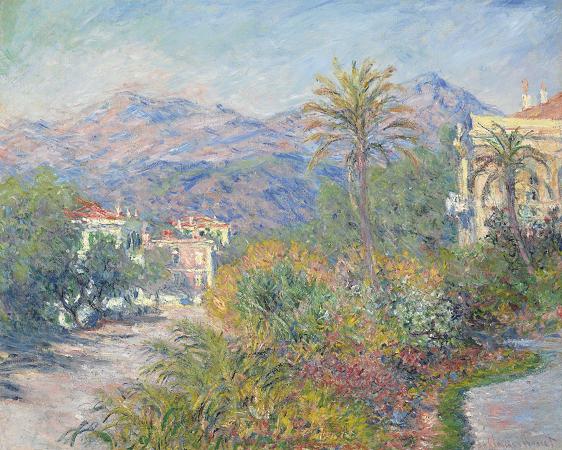Bordighera. Bordighera is a town and comune in the Province of Imperia, Liguria. Bordighera is located at 20 kilometres from France and it is possible to see the French coast with a naked eye from the town. Having the Capo Sant'Ampelio which protrudes into the sea, it is the southernmost commune of the region. The cape is at around the same latitude of Pisa and features a little church built in the 11th century for Sant'Ampelio, the patron saint of the city. Since Bordighera is built where the Maritime Alps plunge into the sea it benefits from the Foehn effect which creates a special microclimate that has warmer winters. It seems that has been inhabited since the Palaeolithic era, as archaeologists have found signs of human activities in the caves on the Italian and French coast. The first humans to alter the territory and create a structured society arrived in the 6th century B.C. They were the Ligures, from whom the name of the region, Liguria in Italian, is derived. The name of the city appears for the first time as Burdigheta in 1296, in a papal Bill of by Pope Boniface VIII. The area was particularly prosperous during Roman times because it was situated on the via Julia Augusta in the 1st century B.C. After the fall of the Roman Empire the village was abandoned because of the frequent attacks by pirates and it is only in 1470 that some families of nearby villages such as the Borghetto San Nicoḷ decided to return to Bordighera. The Moorish pirates became rarer and rarer even though some particularly cruel raids still occasionally happened such as the one by the pirate Hayreddin Barbarossa in 1543. With pirate attacks diminishing the strategic importance of the area became obvious to the Dukes of Savoy and the Republic of Genoa which fought for the territory in the 16th century. The small village was quickly transformed into a fortified town and gained importance until it became independent from the rival city Ventimiglia in 1683. On 20 April 1686, the representants of eight villages, Camporosso, Vallebona, Vallecrosia, San Biagio della Cima, Sasso, Soldano, Borghetto San Nicoḷ and Bordighera had a meeting at the St. Bartholomew Oratory to build what will be called Magnifica comunità degli otto luoghi. The goal of this meeting was to unite and gain independence from the nearby rival city of Ventimiglia. In 1797 Bordighera lost its independence completely and became part of the Palms Jurisdiction, a region including all the land from Ventimiglia to Arma di Taggia with Sanremo as its capital. The next change of power in the region came in 1815 when the whole of Liguria was annexed to the Kingdom of Sardinia after the Congress of Vienna. The Napoleonic influence, however, remained and continued to influence the area. A good example of this is the La Corniche road which Napoleon Bonaparte had wanted, and which reached Bordighera, facilitating the movement of people and goods and boosting the development of what was once called Borgo Marina and today constitutes Bordighera. The old town is simply called Old Bordighera or Upper Bordighera due to its position over the hill. The Golden Age of the city came in the 19th century when the lower city was built next to the Corniche road and the sea which attracted English tourists. Touristic interest in Bordighera seems to have been sparked by a novel from Giovanni Ruffini, Il Dottor Antonio which was published in 1855 in Edinburgh and featured the town. In 1860, five years after the famous novel Il Dottor Antonio was published, Bordighera's first hotel was opened, then called in French Hotel d'Angleterre, now known as Villa Eugenia, at Via Vittorio Emanuele 218. The hotel hosted its first famous resident in 1861, British Prime Minister Lord John Russell, 1st Earl Russell, grandfather of Bertrand Russell. In 1873, the railway station was opened, allowing travel from Paris to Bordighera in only 24 hours, which at the time was remarkably fast. With the opening of the Calais-Rome Express railway on 8 December 1883, travel times got even shorter and 24 hours would be enough to travel from London to Bordighera. In 1887, Stéphen Liégard, in his famous book La Cote d'Azur, dedicated several pages to Bordighera and gave it a name that stuck: Queen of the Palm Trees. He also noted that the Grand Hotel de Bordighera hosted Empress Eugenie in the autumn of 1886. In the 1890s, the Irish naturalist and early modernist writer Emily Lawless visited Bordighera a number of times, studying the local flora. In 1894, she wrote the essay Two Leaves from a Note-Book about a trip to Bordighera, describing the stunning changes in the landscape during and after a drought.
more...




